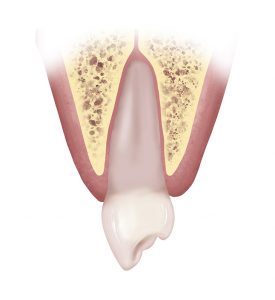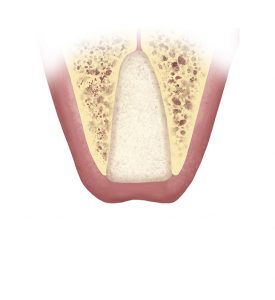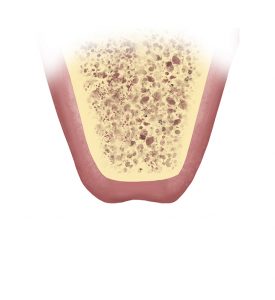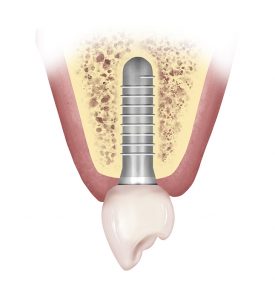Guide to Multiple Implants
The information in the Guide to Multiple Implants provides a comprehensive explanation of the consequences of missing teeth, a comparison of dental implants and bridges, and a detailed description of implant procedures. We encourage you to review all of the pages to help you make an informed decision about your treatment options.
Anterior Implant Procedures: Replacing Teeth that Are Failing
Teeth supporting a traditional, tooth-supported bridge often fail over time and the bridge must be replaced. The failure can be the result of significant decay, failed root canal therapy, or fracture of one or both of the teeth supporting the bridge. In these situations dental implant treatment is the ideal option for most patients.
There are three steps in the treatment process:
- Surgical removal of the failed teeth, usually with bone grafting to maintain the natural contours of the bone and gum tissue
- Placement of the dental implants, either immediately after removal of the teeth, or several weeks following tooth removal
- Attachment of the final implant-supported bridge
Immediate Dental Implant Placement
The first step in the treatment process is removal of the failed bridge, followed by a special surgical technique to remove the teeth, while preserving the bone and gum tissue to create the ideal site for implant placement. Since this procedure is technique sensitive, it is usually performed by surgical specialists with extensive experience removing teeth in preparation for dental implants.
Immediately after the teeth are removed, dental implants are placed using a delicate surgical technique to avoid damaging the bone. Bone grafting material is often placed around the implants, filling in the sockets completely to maintain natural contours. The position of the dental implants is critical to ensure that the new crowns or bridge emerge from the gum tissue exactly like natural teeth and function properly. Due to the precision required for this procedure, the surgical specialist must be experienced with immediate anterior implant placement to ensure a successful outcome.
Since provisional (temporary) replacement teeth are necessary for esthetic purposes, a bridge or removable partial denture is placed immediately after the surgical procedure. The bridge or partial is placed so that it does not touch the teeth in the opposite jaw to keep the forces of biting off of the dental implants, allowing the bone to remodel around the implants without movement or pressure. Even gentle biting force, causing minor movement, can prevent the bone from fusing to the dental implants. Once the bone has formed a strong bond with the dental implants, providing a stable foundation, the final crowns, or bridge can be attached to the implants.
Delayed Dental Implant Placement
In cases where there is insufficient bone to stabilize the dental implants immediately following removal of the failed teeth, the surgical specialist could determine that it would be better to delay implant placement. A bone graft placed following tooth removal, as seen in the illustrations below, fills in the socket where the tooth root is missing, preserving the natural contours of the bone and gum tissues.




The bone graft allows the surgical specialist to place the dental implants in bone that provides stronger initial stabilization of the dental implants. After the dental implants are placed, a provisional (temporary) bridge or partial denture is placed so that it does not touch the teeth opposite them, avoiding biting forces that can cause movement of the dental implants.
The dental implants are left undisturbed for several weeks so that the bone can remodel around, or fuse to the dental implants. Following the appropriate period of time, as determined by the surgical specialist, a small connector post called an abutment is attached to each of the dental implants. The final bridge will be attached to these abutments.
Replacing Teeth That Are Already Missing
In cases where the teeth have been missing for an extended period of time, the surgical specialist must determine whether there is sufficient bone remaining for placement of dental implants. Both the quality and quantity of bone where the dental implants will be placed must be evaluated. 3D cone beam images with computer-generated scans are often used to facilitate the diagnosis and treatment planning process, as they provide a more detailed look at the existing teeth, bone, nerves, and tissue with both three-dimensional and cross-sectional views.
If a substantial amount of bone has been lost, bone grafting is usually required to create an ideal site for placement of dental implants in the front of the mouth. This is necessary to achieve the ideal functional and esthetic result. Without bone grafting, the bone and gum tissue contours will not look natural.
After a predetermined period of time following the bone grafting procedure, usually a few months, a delicate surgical technique is used to shape the bone for the precise placement of dental implants. The position of the dental implants is critical to ensure that the crowns emerge from the gum tissue exactly like natural teeth.
Options for provisional (temporary) replacement teeth include a bridge or a removable partial denture. The provisional replacement teeth are primarily for esthetic purposes, rather than function. They are placed so that they do not touch the teeth opposite them to keep the forces of biting off of the dental implants, allowing the bone to remodel around the implants without movement or pressure.
The dental implants are left undisturbed for several weeks, or a few months, so that the bone can remodel around, or fuse to the dental implants. Once the bone has formed a strong bond with the dental implants, small connector posts called abutments are attached to the dental implants. The final bridges will be attached to these abutments.